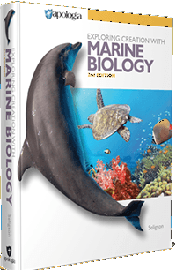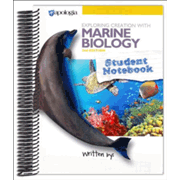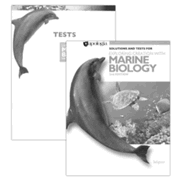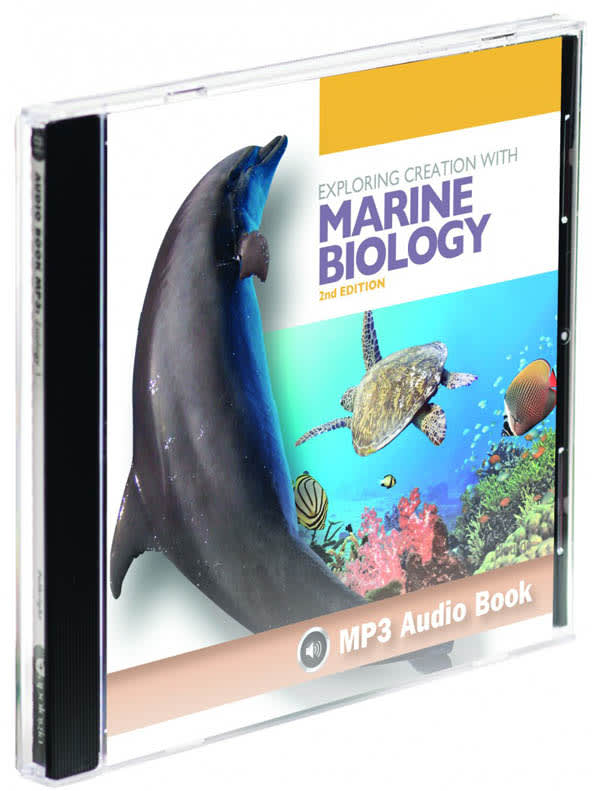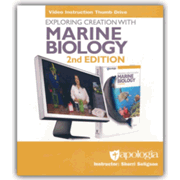Homeschooling parent and marine biologist Sherri Seligson created Exploring Creation with Marine Biology as a high-school level marine biology course. This course follows a format similar to that of Apologia's other high school courses that are among my Top Picks.
This course investigates marine environments and ecologies, life forms from microscopic organisms through huge whales, the geology of the ocean floor and shorelines, and the effects humans have on the oceans and seas. The course clearly reflects a Christian worldview. This is particularly evident in some of the sidebar articles that are presented under the headings "think about this," "creation connections," and "dive in."
Exploring Creation with Marine Biology has three print components: a hardcover student textbook, a spiral-bound student notebook, and a solutions and tests packet.
The hardcover, 557-page student textbook features full-color illustrations and an attractive layout that is significantly improved from the first edition. The textbook is also available as an ebook.) Lessons are presented in 14 units, called modules in this course, and there are many lessons within each module.
The text is relatively easy to read, even though there is quite a bit of new vocabulary for students to master. Many course questions require students to simply recall information from the textbook, but some questions also require critical thinking skills. Ninth and tenth graders might be able to successfully complete the course, but usually, they should have taken their basic biology and chemistry courses first. In fact, the publisher says that an introductory high school biology course is a prerequisite. Lab activities and experiments are incorporated directly into the textbook at the points where they should be used, so there's no confusion about how to coordinate lab work with the textbook.
Optional audio recordings of the student text are available as downloads or on CDs, and optional video presentations of the lessons are available on DVDs. With the audio presentations, students need to follow along in the textbook to view the illustrations and diagrams. The DVD lessons, taught by the course's author Sherri Seligson, include illustrations and diagrams so that students can watch instead of reading the textbook. DVD lessons are generally short with many running fewer than ten minutes, but those for lab activities tend to run longer. These extra audio and video resources might be very helpful for students who are strong auditory learners or who benefit from having a teacher present the material.
While it might be tempting to use the DVDs and skip the textbook, there are a number of reasons not to do so. The textbook is much easier to use for quick review or reference. The three types of sidebar articles I mentioned above appear only in the textbook. And at the back of the textbook—in addition to a glossary and an index—are appendices with "Reference Figures and Tables," "A Complete List of Lab Supplies," and "Module Summaries." The list of lab supplies should make it much easier to collect all of the resources you will need. The Module Summaries are fill-in-the-blanks exercises that help students master the key ideas and vocabulary for each module. (These are also in the student notebook where students are more likely to use them.)
The 500-page student notebook has both course material and space to write. While it is written primarily for the student, at the beginning are a daily course schedule that is also useful to the parent and a few pages specifically for parents that include information about rubrics and how to grade experiments. Included near the beginning are instructions to students about how to take notes. After this introductory material, the student notebook has two main sections: one for students to use as they work through the lesson material in their textbook and the other for the lab activities.
The first of these two large sections has space for students to take notes as they read the textbook, listen to audio presentations, or watch videos. In the textbook, one or two "On Your Own" questions appear sporadically throughout each module, and students should answer these before continuing to read. Those same questions for each module are presented all in one place in the student workbook with space to write answers. (Answers to the On Your Own Questions are near the end of each module in the student textbook so that students can check their own work—yet another reason you need the student textbook.) Each module in the textbook concludes with a study guide that has vocabulary words to define and questions to answer. The study guide is also repeated in the student notebook, but with additional space for writing answers.
The second large section in the student notebook presents identical, illustrated instructions for lab activities that are in the textbook. However, in the student notebook, there is additional space for students to record data and observations and to write their hypothesis, analysis, and conclusion. The student notebook has a small section at the back that teaches students how to create a presentation poster as a way to present research concisely and attractively.
The solutions and tests packet includes a booklet of tests and a 211-page book titled Solutions and Tests for Exploring Creation with Marine Biology. The booklet has a test for each module in addition to four exams. While the Solutions and Tests book has copies of the tests, it also has answer keys for the tests, all study guides, and the module summaries.
Exploring Creation with Marine Biology is a college-prep lab course. Consequently, lab activities require a microscope, a dissecting kit, dissection specimens, and prepared slides. You can order a set of prepared slides and a set of dissection specimens from Apologia. Since biology is a prerequisite, the course assumes that you already have a microscope and dissection tools from that course. If not, those can also be purchased through Apologia. You will also need to supply a number of household items such as a measuring cup, salt, a turkey baster, plastic wrap, vinegar, balloons, a hammer, and a magnifying glass.
The course is well designed for independent study, and students should even be able to complete the lab work on their own. Parents only need to check answers. All of this makes the course very practical for many homeschooling teens. I know that marine biology is not on the list of required courses for college, but Exploring Creation with Marine Biology should make an excellent third- or fourth-year science lab course for students interested in the subject.




